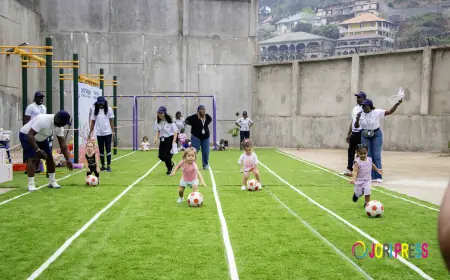2025 Sports Trends: Tech-Enhanced Training & Fan Experiences
Major league teams in basketball, football, and soccer have adopted AI-based systems to monitor and coach players. Even amateur and youth leagues are investing in affordable AI platforms that can be used through smartphones and wearables.
In 2025, the world of sports continues to evolve with tech at the center of it all. Whether it's athlete performance or how fans engage with games, technology is changing the experience. From virtual training environments to real-time data analysis, sports are becoming more interactive and precise. Products like Lostmary are even being casually mentioned in locker rooms and fan zones as athletes and spectators embrace lifestyle changes around sports culture. As athletes chase new records and fans seek deeper engagement, the industry is reshaping itself quickly.

AI-Powered Training for Athletes
Artificial intelligence is now a major tool in helping athletes train smarter. Instead of traditional one-size-fits-all regimens, AI tailors programs to each player’s data. Wearable sensors collect information like heart rate, sleep patterns, hydration levels, and joint stress.
-
AI systems evaluate player workload and adjust exercises in real time.
-
Injury prevention models use historical data to predict risks.
-
Smart cameras track movement mechanics during practice sessions.
-
Coaches receive daily dashboards with individual progress summaries.
Major league teams in basketball, football, and soccer have adopted AI-based systems to monitor and coach players. Even amateur and youth leagues are investing in affordable AI platforms that can be used through smartphones and wearables.
Virtual & Augmented Reality in Practice
Virtual reality (VR) and augmented reality (AR) are helping athletes mentally prepare and sharpen decision-making without physically straining themselves. VR simulations recreate game scenarios, allowing players to practice reading defenses or make passes without needing a full practice session.
-
Quarterbacks review defensive schemes in immersive environments.
-
Boxers practice footwork and timing using AR mirrors.
-
AR headsets overlay stats and cues during live drills.
-
Soccer players use VR to simulate penalty kicks under pressure.
These tools save time, reduce injury risk, and build mental resilience. With virtual training rooms becoming standard in major training centers, many teams see VR and AR as crucial to long-term performance.
Data Analytics in Real-Time Performance
Data analytics is now fully integrated into both games and practices. Coaches and analysts access live stats through wearable tech, smart stadium feeds, and performance tracking tools. Decisions that once took hours are now made instantly during games.
-
Baseball pitchers adjust grip and spin rate mid-game using tablet feedback.
-
Sprinters use stride and velocity data to change form between races.
-
Football coaches swap players based on fatigue markers.
-
Tennis players adapt serve angles based on ball-tracking software.
With edge computing and 5G connectivity, this real-time feedback loop is seamless. Teams have data analysts on staff who interpret visuals, metrics, and probabilities to aid coaching decisions, often relayed through earpieces in real time.
Enhanced Fan Engagement at Venues
Fans are also experiencing sports differently in 2025. Stadiums and arenas are now smart environments built around digital experiences. From entrance to exit, fans interact with the venue through their devices and wearable tech.
-
Mobile apps provide instant replays and multiple camera angles.
-
Augmented reality games entertain fans during breaks.
-
Smart wristbands control access, payments, and in-seat food delivery.
-
Real-time stats appear on screen overlays through AR glasses.
The goal is to make attending live games more immersive than ever. Instead of just watching, fans feel like part of the action—voting on MVPs, analyzing plays, and even engaging in live polls that influence music or visual effects.
Home-Based Interactive Viewing
Not all fans make it to the stadium. For those watching from home, interactive platforms bring the excitement into the living room. Smart TVs, tablets, and streaming platforms now come with features that blend sports and gaming.
-
Fantasy league updates sync live with broadcasts.
-
Multicam streaming allows custom game perspectives.
-
AI commentators provide stat-driven insights and summaries.
-
Watch parties with synchronized viewing are supported across platforms.
Many fans also use products like Lost Mary Strawberry Ice in social settings during watch parties, reflecting how lifestyle items integrate with the modern sports viewing experience. These tools enhance the sense of community and personalization, even when watching alone or remotely.
Personalized Recovery & Nutrition
Sports science isn't just about training—it’s also about recovery. Teams and athletes in 2025 are using tech for injury recovery, sleep enhancement, and nutrition. Personalized programs, often monitored remotely, have become the norm.
-
Smart recovery suits monitor muscle recovery through temperature and blood flow.
-
Apps track sleep cycles and offer suggestions to improve rest.
-
DNA-based nutrition guides recommend meals for energy and recovery.
-
AI platforms detect dehydration and nutritional gaps in real-time.
Hydration patches and body-scanning tools are standard in locker rooms. Every athlete gets a tailored plan that adjusts dynamically, even during a tournament or season. This technology helps prolong careers and enhance daily performance.
Grassroots and Youth Sports
It's not just the pros benefiting. High school and youth sports programs are now adopting basic versions of pro-level tools. Affordable wearables and free AI-based apps are helping young athletes improve form, track stats, and even connect with coaches online.
-
Training drills are generated based on skill level and position.
-
Progress tracking over time helps coaches give better feedback.
-
Video analysis is used for reviewing practice and fixing technique.
-
College scouts often review online data profiles of athletes.
This accessibility ensures that tech-enhanced training isn't limited to elite athletes. It builds a foundation of safety, awareness, and high performance from the grassroots level up.
Eco-Friendly Sports Facilities
In line with sustainability goals, many new training centers and stadiums are eco-conscious. These venues are equipped with energy-efficient lighting, solar panels, and water-saving systems.
-
Smart lighting systems adjust based on crowd movement.
-
Solar-powered scoreboards and field lighting cut energy use.
-
Green roofs and water recycling help maintain grass fields naturally.
-
Digital tickets reduce paper waste and streamline entry.
Sustainability isn't just a buzzword—it's a functional part of sports facility design. Teams are also encouraging fans to adopt eco-friendly behavior through incentives like reusable cups, bicycle parking, and digital rewards.
Community Building Through Tech
Beyond the games, sports are a platform for building community. In 2025, this means digital communities too. Players and fans are connected through platforms that go beyond social media.
-
Players host live training sessions on fan platforms.
-
Teams launch apps for fan suggestions on jersey design or charity efforts.
-
Youth leagues use tech to connect rural talent with urban training centers.
-
Smart fundraising tools help schools upgrade sports facilities.
This connectivity ensures that fans, players, and communities grow together. Whether cheering from home or training on the field, technology is helping make sports more inclusive and connected.
As we move through 2025, it's clear that tech is becoming an inseparable part of sports. From training and injury prevention to fan interaction and sustainable stadiums, the influence is widespread. Even cultural items like Lost Mary Blue Razz Ice reflect how lifestyle preferences blend into the sports experience. Whether you're an athlete pushing limits or a fan celebrating the next big win, the game is evolving—and everyone is part of it.
What's Your Reaction?
 Like
0
Like
0
 Dislike
0
Dislike
0
 Love
0
Love
0
 Funny
0
Funny
0
 Angry
0
Angry
0
 Sad
0
Sad
0
 Wow
0
Wow
0

















































